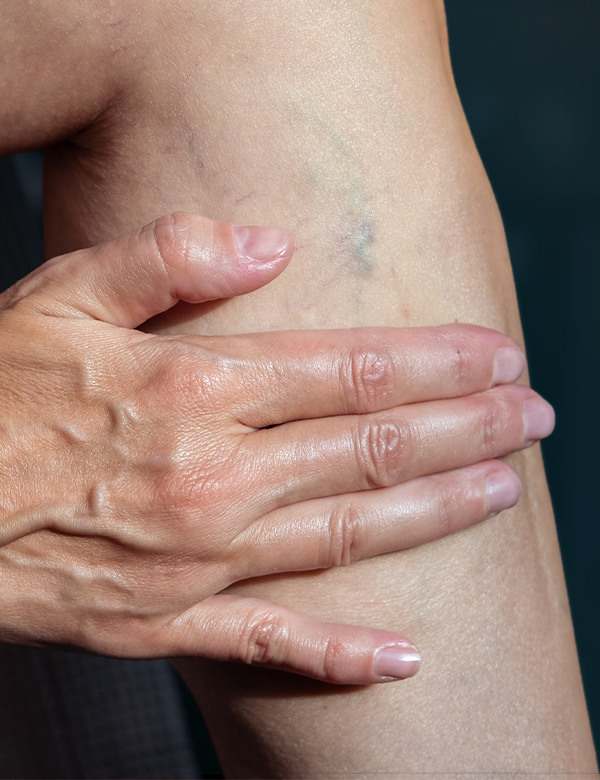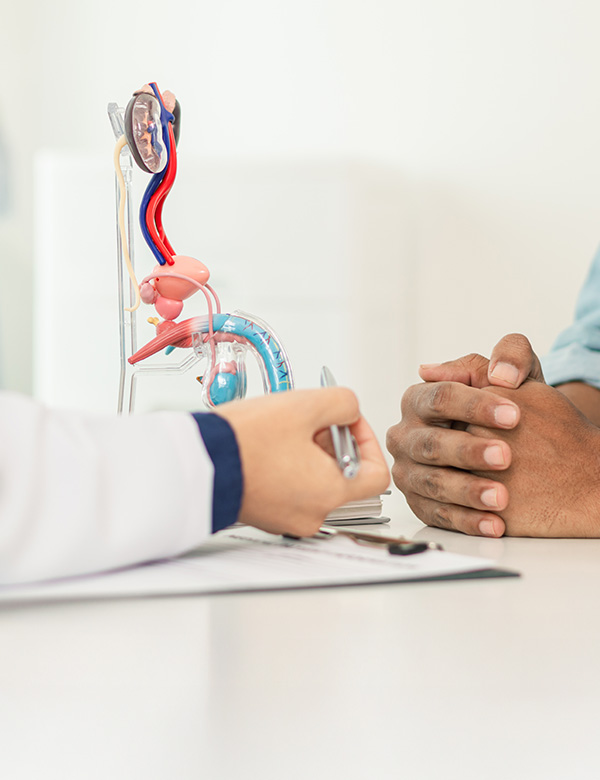Treat Thrombosis
Thrombosis - Clarifying Symptoms: Diagnosis & Therapy by Vascular Specialist at Derma Medical Clinic in Zurich – Sihlcity
Thrombosis
Chronische Abszesse und schmerzhafte Knoten durch erfahrenen Hautarzt abklären und behandeln in der Derma Medical Clinic in Zürich - Sihlcity
Clarification of a possible thrombosis in the arm, leg, pelvic, neck, and abdominal vessels with special vascular ultrasound for suddenly occurring unilateral swelling, feeling of tension/pressure in the skin, or visible, distended veins.
Examinations
Vascular screening
Vascular ultrasound
Procedure
Initial Consultation
Ultrasound
Duration
approx. 30 minutes
Thrombosis Symptoms at a Glance
For whom is thrombosis diagnostics advisable?
What is Thrombosis?
A thrombosis is a blockage of a vein by clotted blood (blood clot).
This can disrupt blood flow and lead to swelling, pain, redness, or distended, visible veins.
If the blood clot detaches, it can lead to a life-threatening pulmonary embolism.
Besides arms and legs, thromboses can also occur in neck, pelvic, and abdominal veins.
This is favored by prolonged sitting or lying down, after surgeries, or during long journeys.
The risk is additionally increased during pregnancy, when taking estrogen-containing hormones (the pill), or with certain pre-existing conditions.
Since the signs can be misleading, venous ultrasound helps to safely assess the situation and make the further course of action plannable.
An examination is recommended if you…
- notice unilateral arm or leg swelling
- notice pressure/calf pain, feeling of tension, redness/warmth, or shiny skin
- detect newly visible, distended veins
- have symptoms after: long-haul flights, anesthesia, bed rest or cast, pregnancy/postpartum, hormonal therapy (estrogens/the pill), cancer/chemotherapy
- have previously had a thrombosis or have a family history
- experience unexplained pain/swelling in the pelvic or abdominal area

For whom is thrombosis diagnostics advisable?
What is Thrombosis?
A thrombosis is a blockage of a vein by clotted blood (blood clot).
This can disrupt blood flow and lead to swelling, pain, redness, or distended, visible veins.
If the blood clot detaches, it can lead to a life-threatening pulmonary embolism.
Besides arms and legs, thromboses can also occur in neck, pelvic, and abdominal veins.
This is favored by prolonged sitting or lying down, after surgeries, or during long journeys.
The risk is additionally increased during pregnancy, when taking estrogen-containing hormones (the pill), or with certain pre-existing conditions.
Since the signs can be misleading, venous ultrasound helps to safely assess the situation and make the further course of action plannable.
An examination is recommended if you…
An examination is recommended if you…
- notice unilateral arm or leg swelling
- notice pressure/calf pain, feeling of tension, redness/warmth, or shiny skin
- detect newly visible, distended veins
- have symptoms after: long-haul flights, anesthesia, bed rest or cast, pregnancy/postpartum, hormonal therapy (estrogens/the pill), cancer/chemotherapy
- have previously had a thrombosis or have a family history
- experience unexplained pain/swelling in the pelvic or abdominal area
Treatment
What Happens if Thrombosis is Suspected?
At the Derma Medical Clinic, our vascular specialist uses a unique screening before every vascular ultrasound: The blood flow in the arms, legs and toes is measured painlessly in just a few minutes using cuffs and small sensors.
Vascular problems such as calcifications or circulatory disorders often appear there first, even before symptoms occur. This allows even early changes to be reliably detected – a diagnostic standard otherwise only offered in specialized vascular centers.
This is followed by vascular ultrasound: We assess blood flow in real-time. Depending on the question, we examine arm or leg veins, and if necessary, neck, pelvic, and abdominal veins. If questions remain, we arrange for further imaging.
What Happens after the Examination?
No thrombosis: We explain the findings, differentiate other causes (e.g., muscle injury, Baker’s cyst, lymph congestion), and discuss whether follow-up monitoring or targeted further investigation is advisable.
Thrombosis confirmed: We identify the location and extent, assess the urgency, and initiate the next steps on the same day (e.g., coordination of medication treatment and planning of follow-up appointments).
Special situations: In pregnancy, after surgeries, or with relevant pre-existing conditions, we coordinate the procedure closely with the treating physicians.
How is thrombosis diagnosed?
Initial Consultation & Assessment
We discuss your symptoms, risk factors, and assess the affected region.
Vascular Diagnostics
Examination of the affected area using vascular ultrasound (arm, leg, neck, pelvic, or abdominal veins).
Evaluation & Therapy
Thrombosis confirmed: We start medication treatment. No thrombosis: We discuss which further investigations are advisable.

At Derma Medical Clinic, the diagnosis and treatment of venous disorders are performed by Dr. Andreas Gutwein, a specialist in Angiology and General Internal Medicine, FA Phlebology.
He is a specialist in vascular diseases and has many years of experience in the diagnosis and treatment of venous disorders.

Dr. med. Andreas Gutwein
Specialist in Angiology and General Internal Medicine FMH
Expert in Vascular Medicine & Men’s Health

Dr. med. Benjamin Miller
Board-certified Specialist in Dermatology and Venereology FMH
What you can expect from us
Angiology: Vascular medicine
Angiology is the specialized medical discipline for veins, arteries, and lymphatic vessels. At Derma Medical Clinic, thromboses are exclusively examined by an experienced specialist in angiology.
Vascular ultrasound: precise diagnostics
Vascular ultrasound shows blood flow in real-time and detects whether a vein is blocked. The examination is painless, involves no radiation exposure, and is performed directly in our clinic. You receive the result immediately, without waiting time.
Vascular medicine meets dermatology
Many vascular diseases first become noticeable on the skin – through swelling, discoloration, or visible veins. In the Derma Medical Clinic, vascular medicine and dermatology therefore complement each other perfectly.
Everything under one roof
You receive diagnosis, medical treatment, and cosmetic support in one place. This means you have fixed contact persons, short distances, and coordinated care, from the initial examination to aftercare.
Suddenly swollen leg, hardened vein cords, or pressure pain in the calf?
Schedule an appointment now for individual consultation and treatment at Derma Medical Clinic in Zurich.
FAQ – Frequently Asked Questions about Thrombosis
What symptoms can indicate thrombosis?
Typical signs include sudden swelling, pain, feelings of tension, redness, or warmth in the arms or legs. In the abdominal or pelvic area, abdominal pain, swelling, or a feeling of fullness may occur. Thrombosis in the neck area sometimes manifests as swelling and a feeling of pressure in the neck or shoulder.
How is thrombosis diagnostics performed?
First, your symptoms and risk factors are discussed. Afterwards, vascular screening and vascular ultrasound are used. Depending on the location, CT or MRI may also be useful to reliably clarify thromboses in pelvic, abdominal, or neck veins.
Why is an additional screening performed at the Derma Medical Clinic before each vascular ultrasound?
We use the AngE™ ABI+ Screening because it measures blood flow in the arms, legs, and toes precisely and painlessly within a few minutes. Vascular problems such as calcifications or circulatory disorders often show up there first, even before symptoms arise. This gives you a particularly reliable examination – a diagnostic standard that is otherwise only offered in specialized vascular centers.
Which doctor performs thrombosis diagnostics?
The initial assessment can be done by a general practitioner. For a reliable diagnosis – especially for thromboses outside the leg veins – angiologists (vascular specialists) are specialized. They possess the necessary ultrasound technology and experience.
How reliable is ultrasound in thrombosis diagnostics?
Special vascular ultrasound is considered the gold standard, especially for leg and arm veins. In very rare cases, visibility in pelvic or abdominal veins may be limited, which is why further imaging procedures (CT/MR phlebography) are used for unclear findings.
Can I determine myself if I have thrombosis?
No, a reliable self-diagnosis is not possible. Symptoms such as swelling, pressure, pain, or discoloration must be medically examined, as they can have various causes.
When should I see a doctor immediately?
In case of acute swelling or pain in an arm, leg, neck, or abdomen, immediate medical clarification should be sought. If shortness of breath or chest pain also occurs, there is a risk of a life-threatening pulmonary embolism.
How is thrombosis investigated during pregnancy?
During pregnancy, ultrasound is primarily used as it causes no radiation exposure.



